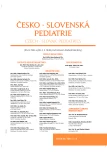Neonatal hyperbilirubinemia in a Vietnamese child – case report
Authors:
D. Bauer 1; M. Jirsa 2; M. Magner 1,3; P. Kabíček 1
Authors‘ workplace:
Pediatrická klinika 1. LF UK a Thomayerovy nemocnice, Praha
1; Ústav lékařské biochemie a laboratorní diagnostiky, 1. LF UK a Centrum experimentální medicíny IKEM, Praha
2; Klinika pediatrie a dědičných poruch metabolismu 1. LF UK a VFN, Praha
3
Published in:
Čes-slov Pediat 2020; 75 (6): 342-345.
Category:
Overview
The causes of neonatal hyperbilirubinemia in Asian and Caucasian population differ. There is a higher incidence of Asian forms of Gilbert's syndrome (GS), Southeast Asian Ovalocytosis, 6-glucose phosphatedehydrogenase deficiency, thalassemia and sickle cell anemia in the Asian population.
We describe a case of a eutrophic Vietnamese boy from the second pregnancy, who was admitted to the hospital for marked icterus and fatigue with unconjugated hyperbilirubinemia of 455 µmol/l. Laboratory examinations did not support suspicion of alloimmunization (blood type of the child 0+, mother B+, direct Coombs test negative), or increased haemolysis (reticulocytes 5.8 ‰), liver function tests were normal. Levels of bilirubin dropped rapidly after phototherapy, the boy was discharged and followed-up by general practitioner. At three weeks of age, the boy returns with total bilirubin level of 389 µmol/l. The directly indicated molecular genetic examination documented the mutation c.211G>A (p.Gly71Arg) in the first exon of the UGT1A1 gene in a homozygous form. The gene encodes the enzyme bilirubin UDP-glucuronyltransferase, which is essential for the conjugation of bilirubin in hepatocytes. It is important to emphasize that the prevalent mutation in GS in the Caucasian population is located in the promoter of the gene and that genetic testing for these mutation in the Caucasian population would miss this form of GS.
Keywords:
neonatal hyperbilirubinemia – Gilbert's syndrome – Asian population – bilirubin uridindifosfoglukuronyltransferáza
Sources
1. Keevak M. Becoming Yellow: A Short History of Racial Thinking. Course Book. Princeton: Princeton University Press, 2011.
2. De Luca D, Jackson GL, Tridente A, et al. Transcutaneous bilirubin nomograms, a systematic review of population differences and analysis of bilirubin kinetics. Arch Pediatr Adolesc Med 2009; 163 (11): 1054-1059.
3. Bentz MG, Carmona M, Bhagwat MM, et al. Beyond “Asian”: specific East and Southeast Asian races or ethnicities associated with jaundice readmission. Hosp Pediatr 2018; 8 (5): 269–273.
4. Dort J, Tobrmanová H. Hyperbilirubinemie novorozence, doporučený postup péče. http://www.neonatology.cz/upload/www.neonatology.cz/Legislativa/Postupy/hyperbilirubinemie.pdf
5. American Academy of Pediatrics Subcommittee on Hyperbilirubinemia. Management of hyperbilirubinemia in the newborn infant 35 or more weeks of gestation. Pediatrics 2004; 114 (1): 297–316.
6. Kadakol A, Ghosh SD, Sappal BS, et al. Genetic lesions of bilirubin uridine-diphosphoglucuronateGlucuronosyltransferase (UGT1A1) causing Crigler-Najjar and Gilbert syndromes: correlation of genotype to phenotype. Hum Mutat 2000; 16 : 297–306.
7. Fretzayas A, Moustaki M, Liapi O, Karpathios T. Eponym Gilbert syndrome. Eur J Pediatr 2012; 171 : 11–15.
8. Strassburg CHP. Hyperbilirubinemia syndromes (Gilbert-Meulengracht, Crigler-Najjar, Dubin-Johnson, and Rotor syndrome). Best Pract Res Clin Gastroenterol 2010; 24 : 555–571.
9. Van Dijk R, Beuers U, Bosma PJ. Gene replacement therapy for genetic hepatocellular jaundice. Clin Rev Allergy Immunol 2015; 48 (2-3): 243–253.
10. Long J, Zhang S, Fang X, et al. Neonatal hyperbilirubinemia and Gly71Arg mutation of UGT1A1 gene: a Chinese case-control study followed by systematic review of existing evidence. Acta Paediatrica 2011; 100 : 966–971.
11. Barcellini W, Bianchi P, Fermo E, et al. Hereditary red cell membrane defects: diagnostic and clinical aspects. Blood Transfus 2011; 9 (3): 274–277.
12. Prayongratana K, Viprakasit V. Co-inheritance of Southeast Asian Ovalocytosis (SAO) and G6PD deficiency associated with acute hemolysis in a Thai patient. Blood Cells Mol Dis 2019; 79 : 102347. doi:10.1016/j.bcmd.2019.102347. PMID: 31323480.
13. Frank JE. Diagnosis and management of G6PD deficiency. Am Fam Physician 2005; 72 (7): 1277–1282.
14. Cavazzana M, Antoniani Ch, Miccio A. Gene therapy for β-hemoglobinopathies. Mol Ther 2017; 25 (5): 1142–1154.
15. Wang JS, Wang XH, Zheng YJ, et al. Biochemical characteristics of neonatal cholestasis induced by citrin deficiency. World J Gastroenterol 2012; 18 (39):5601–5607.
16. Laosombat V, Viprakasit V, Dissaneevate S, et al. Natural history of Southeast Asian Ovalocytosis during the first 3 years of life. Blood Cells Mol Dis 2010; 45 (1): 29–32.
17. Kelly N. Thalassemia. Pediatr Rev 2012; 33 (9):434–435.
18. Meier ER, Miller JL. Sickle cell disease in children. Drugs 2012; 72 (7): 895–906.
Labels
Neonatology Paediatrics General practitioner for children and adolescentsArticle was published in
Czech-Slovak Pediatrics

2020 Issue 6
Most read in this issue
- Extreme hypokalaemia in familial periodic paralysis – case report
- Ascaris: a rare cause of nighttime abdominal pain in children – case report
- Brain abscess in children – overview and two case reports
- Vasculitis as a rare manifestation of Sarcoptes scabiei infestation – case report
